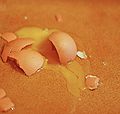Difference between revisions of "Albumen, Egg"
| (9 intermediate revisions by 2 users not shown) | |||
| Line 1: | Line 1: | ||
| + | {{Infobox_Miscellaneous | ||
| + | | image = albumenegg.jpg | ||
| + | | origin = Various | ||
| + | | stowage factor = - | ||
| + | | humidity and moisture = - | ||
| + | | ventilation = - | ||
| + | | risk factors = See text | ||
| + | }} | ||
==Description== | ==Description== | ||
| − | + | Egg white is the common name for the clear liquid (also called the albumen or the glair/[[glaire]]) contained within an egg. In chickens it is formed from the layers of secretions of the anterior section of the hen's oviduct during the passage of the egg. It forms around either fertilized or unfertilized egg yolks. The primary natural purpose of egg white is to protect the yolk and provide additional nutrition for the growth of the embryo (when fertilized).<br><br> | |
| + | Egg white consists primarily of about 90% water into which is dissolved 10% proteins (including albumins, mucoproteins, and globulins). Unlike the yolk, which is high in lipids (fats), egg white contains almost no fat, and carbohydrate content is less than 1%. Egg white has many uses in food (e.g. mousse) and also many other uses (e.g. in the preparation of vaccines such as those for influenza).<br><br> | ||
| + | The product is shipped in dried or frozen form.<br><br> | ||
| + | See also [[Albumen, Blood]]<br><br> | ||
| + | ==Applications== | ||
| + | Used in the bakery trade, the sugar confectionery industry and in the clarification of wines. Is not prime if excessive moisture is present or if it is reddish in parts, and has been adulterated, or if there is any boracic acid content. This product is not adulterated except in the rare case when inedible albumen is sold for industrial purposes.<br><br> | ||
| + | ==Shipment/storage== | ||
| + | Usually packed in tins inside cases. When frozen, must be carried in a refrigerated compartment at minus 15°C or lower. <br><br> | ||
| + | ==Risk factors== | ||
| + | * Moisture damage | ||
| + | * Foreign odours | ||
| − | |||
[[Category: Products]] | [[Category: Products]] | ||
| − | [[Category: | + | [[Category: Miscellaneous]] |
Latest revision as of 13:38, 4 October 2012
| Infobox on Albumen, Egg | |
|---|---|
| Example of Albumen, Egg |  |
| Facts | |
| Origin | Various |
| Stowage factor (in m3/t) | - |
| Humidity / moisture | - |
| Ventilation | - |
| Risk factors | See text |
Albumen, Egg
Description
Egg white is the common name for the clear liquid (also called the albumen or the glair/glaire) contained within an egg. In chickens it is formed from the layers of secretions of the anterior section of the hen's oviduct during the passage of the egg. It forms around either fertilized or unfertilized egg yolks. The primary natural purpose of egg white is to protect the yolk and provide additional nutrition for the growth of the embryo (when fertilized).
Egg white consists primarily of about 90% water into which is dissolved 10% proteins (including albumins, mucoproteins, and globulins). Unlike the yolk, which is high in lipids (fats), egg white contains almost no fat, and carbohydrate content is less than 1%. Egg white has many uses in food (e.g. mousse) and also many other uses (e.g. in the preparation of vaccines such as those for influenza).
The product is shipped in dried or frozen form.
See also Albumen, Blood
Applications
Used in the bakery trade, the sugar confectionery industry and in the clarification of wines. Is not prime if excessive moisture is present or if it is reddish in parts, and has been adulterated, or if there is any boracic acid content. This product is not adulterated except in the rare case when inedible albumen is sold for industrial purposes.
Shipment/storage
Usually packed in tins inside cases. When frozen, must be carried in a refrigerated compartment at minus 15°C or lower.
Risk factors
- Moisture damage
- Foreign odours











